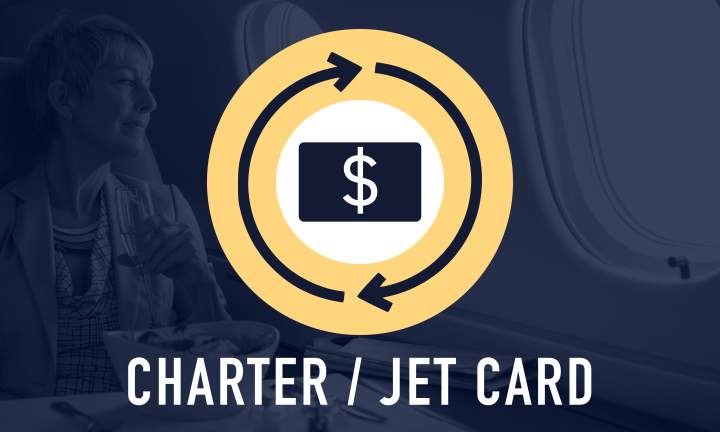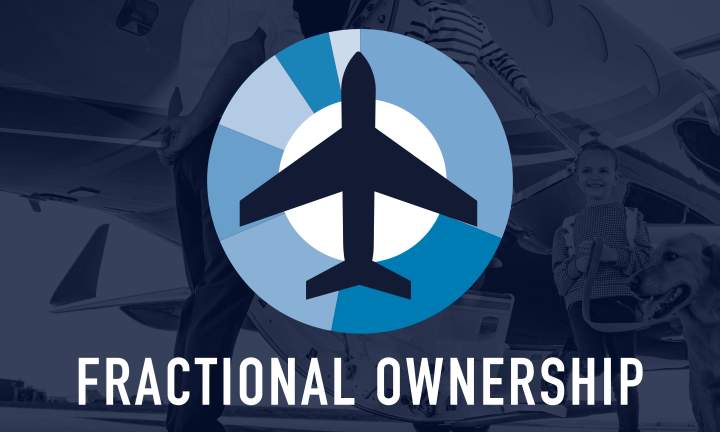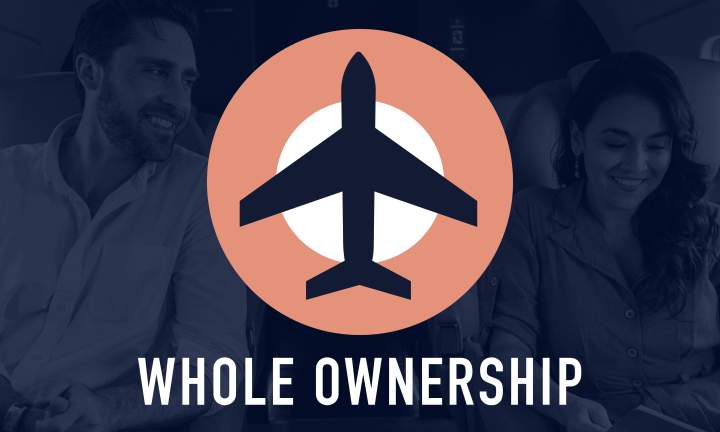Looking to expand your horizons with private flight?
In this white paper, AirSprint explains your private flight options, discusses the pros and cons of each, and lays out a few guidelines to help you stay grounded – even while you’re dreaming of flying above the clouds.
Learn about whole aircraft ownership, charter, jet cards and fractional ownership – and get expert advice on how to choose the one that’s right for you.
Let's get started...



Checking in on a Strong Market
Since the COVID-19 global pandemic, private aviation has enjoyed an unprecedented spike in popularity, as more people discover the safety, flexibility and convenience of customized air travel.
“We’ve seen a step change in the demand for private aviation,” confirmed Rolland Vincent, President of Rolland Vincent Associates LLC and Creator/Director of business aviation intelligence firm JETNET iQ. “That’s not going away; that hasn’t diminished at all.”
However, within the world of private aviation, some sectors are growing faster than others. Vincent outlined a few key facts.
First, it’s important to realize the market is coming off a historic pandemic-induced peak – but it’s still healthy today.
“Pre-owned aircraft sales have dropped about 20 per cent year-over-year, but 2022 was an incredible year and 2021 even more so,” noted Vincent. “As for new aircraft, none of the OEMs has any delivery positions available for 2024 – it’s mid-2025 at the earliest. As well, we’re not seeing any signs of order cancellations and pricing remains solid.”
Second, while there has been some softening in the pay-as-you-go aircraft charter market in Canada, the U.S. and Europe, the industry analyst said fractional ownership continues to show strong growth.
“You do have to buy a part of the plane and pay monthly and hourly fees, but you are getting all of the service,” said Vincent. “I think people are getting busier in life, and that means they will rely more on trusted advisers to manage and maintain their aircraft. I like the service, too. The fleet providers are doing a great job delivering a top quality product.”
Third, Vincent said “airplanes are holding their values like we haven’t seen – the values have been strong. It’s been a complete seller’s market. Normally, an airplane is a depreciating asset, but the real takeaway here is that there is an economic argument to hold its value.”
Looking at the Options
In Canada, there are basically three options when it comes to flying private: whole ownership, charter (including jet cards), and fractional ownership. Here, we’ll examine the pros and cons of each one.
Whole Ownership
Just as it sounds, whole ownership means that an individual or a corporation buys an entire plane and makes all related managerial decisions.
Perhaps they will work with a management company that will charter it out on their behalf. Or, they might opt to hire a chief pilot who will manage an in-house flight department. Either way, whole ownership carries certain benefits as well as important financial considerations.

Pros
“With whole ownership, you have maximum flexibility,” said James Elian, President and CEO of AirSprint Private Aviation. “Operations are completely on your schedule and you can configure your aircraft as you see fit, much like a high-end home. If you want multi-coloured seats, you can have them. From a regulatory standpoint, you are deemed to be a private operator, so you can maximize your flexibility when going into foreign countries and access shorter runways.”
Cons
“The biggest drawback with whole ownership is that you are taking on all of the associated costs – so not many people can afford it,” said Elian. “There’s the initial capital cost to buy the plane, plus all the fixed fees: maintenance, pilots, crew training, insurance. As well, when aircraft are in the shop for scheduled or unscheduled maintenance, you can’t use them.”
He added that it is difficult to find and train pilots these days. If you lose one, you might not be able to fly your plane – or, you’d be forced to find a contract pilot and pay premium rates.
One of the other considerations is fees associated with repositioning, said Elian.
“Let’s say the purchaser doesn’t own it alone – they share the aircraft with a friend. So they split the costs, but they also split the availability. One might take the jet to Florida and then the next day, it has to be flown back empty in order to pick up the other partner so they can go somewhere else. It can be difficult to optimize the mission profile of the aircraft without overspending.”
While Elian said the right 50/50 partnership can work, he also said it’s a challenge for owners to find the ideal arrangement.
On-demand Charter
When you charter an aircraft, you just pick up the phone and call for a flight.
“Think of the charter model like Uber,” said Rolland Vincent of JETNET iQ. “The growth of the big charter brands is something we’ll continue to see, with synergies and economies of scale.”
Here, we examine some of the advantages and considerations associated with chartering an aircraft.

Pros
Private aircraft chartering is essentially a simple, on-demand service.
“There is no capital requirement and no commitment,” said AirSprint’s James Elian. “You can request the aircraft type that is best suited for your mission, and the schedule is flexible. You can have the aircraft for a day or several days.”
In Canada, a small number of charter operators own their aircraft outright. However, the majority charge a fee to manage – and charter out – an aircraft that is owned by someone looking to recoup some of the costs of whole ownership.
Cons
Although you can certainly request what kind of aircraft you want and when, availability is not always guaranteed – especially with short notice and in peak travel times. Sometimes, you may have to settle for a different type of aircraft that might cost more.
Plus, charter customers are billed for so-called empty legs – “If you’re going to Florida for three weeks, you pay for the plane to take you down there, come back empty, and do it all over again when your trip is over,” explained Elian.
While convenient, chartering can also be expensive, since fees are calculated on a per-hour or per-mile basis (with the management company and the owner both needing to make money). There may also be hidden fees that are not included in the initial charter quote. Examples include airport and hangar fees, de-icing charges, onboard Wi-Fi service, repositioning fees, crew accommodation and expenses, and charges for wait time. It’s also a good idea to ask about the operator’s insurance coverage to see if it is adequate, as well as clarify their position on cancellation fees.
A word about jet cards...
Jet cards are essentially pre-paid charter hours, according to AirSprint’s James Elian.
“It benefits the charter company to have a jet card. They ask for a deposit of several thousand dollars to have access to a certain class of airplane at a certain rate. It’s like block charter, in a way. You get a bit of a deal on the rate or maybe some additional access privileges.”
Canadian jet card programs tend to be more about block hours, while U.S. programs can be more structured, perhaps even offering upgrade or downgrade privileges.
“The pros are the same as on-demand charter,” added Elian. “As far as the cons, you are putting down a significant amount of money with no asset attached to it. It’s something to be careful of, in terms of knowing who you’re dealing with.”
Added Rolland Vincent: “It’s a commitment a customer makes to an organization, so try to understand what’s going on and who’s behind it. I always like to think, ‘If I’m putting the most important people in my life on a plane, who is operating and controlling it? Who is behind this, who owns the operating certificate?’ I’d prefer someone who has skin in the game, not just a marketing company.”
Fractional Ownership
Fractional aircraft ownership was introduced in the U.S. in the mid-1980s, evolving from the idea of sharing both ownership and the associated costs.
“The fractional world has been doing this for a long time in terms of the shared economy,” said James Elian. “It’s about better utilizing the aircraft and dividing the fixed costs to make private aviation more accessible to exponentially more people.”
Founded in 2000, AirSprint Private Aviation is Canada’s fractional ownership expert, with a fleet of 36 aircraft serving more than 500 Fractional Owners.

Pros
Elian listed the benefits of fractional ownership, including an optimized cost structure suited to an individual’s unique needs.
Essentially, AirSprint Fractional Owners have two turn-key options: a capital purchase or a five-year lease. They pay a one-time capital purchase fee or an initial refundable lease deposit, and then a flat annual overhead fee that covers the cost of maintenance, crew, pilots and everything else they will need. There is an hourly rate charged for the time spent on board, and lessees also pay an annual lease fee.
“For every three per cent of a plane you buy, you get 25 hours a year,” explained Elian. “You save on capital costs and fixed costs, while financial risk transfers to the operator, so costs stay low. The operator must arrange maintenance, insurance and pilots, as well as making operational decisions.”
One big advantage of fractional ownership? No repositioning fees.
“You can call from anywhere in North America and we will pick you up at no cost to you, and you only pay when you are on board,” said Elian. “You can also upgrade or downgrade your jet type, depending on your specific flight requirements.”
Additionally, annual aircraft maintenance, crew vacations or pilot sickness have zero impact on the travel plans of AirSprint Fractional Owners, because they are guaranteed access to a fleet of identical aircraft. They are also backed by the company’s 24 years of experience and professional accounting, service, maintenance and safety teams – instead of relying on just one pilot or an in-house team to determine operational safety.
Elian added: “We have over 300,000 hours of flight operations experience at AirSprint. We have 185 pilots who fly according to our stringent operating procedures, like the airlines, and we own more aircraft. In fact, in the first two weeks of the year, we log more hours on our types of aircraft than a typical operator would on that type in the whole year.”
Plus, as Rolland Vincent pointed out, fractional owners have the opportunity to “mix and match” their lift requirements – opting to fly commercial when travelling to a larger city, for example, and saving their own private jet hours for smaller destinations or trips with multiple stops.
Cons
There are a few things to consider with fractional ownership, said Elian.
To ensure fleet consistency, the exterior paint and interior colour scheme of your aircraft will be selected by the fractional operator.
As well, once a flight is booked, it must typically depart on schedule – at AirSprint, a customer’s Personal Flight Concierge can advise on the options applicable to each situation.
“Sometimes, operational costs in a fractional ownership program could be more expensive than whole aircraft ownership,” Elian pointed out. “It really depends on how you use the aircraft, with same day return flights being less efficient than longer trips in the fractional model.”
Which Option is Right for You?
In general, the best private flight option for you depends on your budget and projected utilization. Here are some handy guidelines to inform your decision – but remember, one size does not fit all! Your individual needs, budget and mission profile will play a big part in which private flight option is your best choice.
25 or less flight hours per year
On-demand Charter is probably your best choice
25 to 50 flight hours per year
Compare Jet Cards and Fractional Ownership
50 to 250 flight hours per year
Fractional Ownership offers flexibility and hassle-free private travel solutions
250+ flight hours per year
It may be time to investigate Whole Aircraft Ownership
“When choosing the best private aviation plan for you, consider cost as well as frequency and guarantee of access. There is no one solution that is best for everyone,” said James Elian, President and CEO of AirSprint Private Aviation.
“Fractional is very popular and it can meet most needs,” he continued. “Over the past year, the largest gains have been on the fractional side. Guaranteed access and service has been popular and sharing an aircraft makes sense.”
Do you need help determining your typical flight hours per year? Our Flight Time Calculator is the perfect solution. Just select your departure and arrival locations, indicate one-way or round-trip, and multiply by the number of trips you plan to take annually.
Doing Your Homework
James Elian, President and CEO of AirSprint, and Rolland Vincent, President of Rolland Vincent Associates LLC and Creator/Director of business aviation intelligence firm JETNET iQ, offer the following tips for those looking to venture into the world of private aviation:
- Read, read, read. Over the last few years, reputable companies, business aviation associations and industry groups have published a plethora of materials – written and video – discussing private flight options. Three reliable sources are the Canadian Business Aviation Association (CBAA), the U.S. National Business Aviation Association (NBAA), and Rolland Vincent’s free digital report, JETNET iQ Pulse.
- Contact private aviation operators (for charter, fractional) and aircraft manufacturers and aircraft brokers (for new and pre-owned whole ownership). Ask questions. “Within a couple of hours, you will probably have an idea of what might be a good fit,” said Elian. “There is an element of ‘if it sounds too good to be true, ask more questions.’ It’s a relatively small industry, especially in Canada, and if you ask enough reputable people, you’ll get to the right answer.”
- When you find a company you trust, ask to speak with a few references. You’re going to put yourself and people you care about up in the air, spending a good amount of money along the way – so do your homework.
- If you’re dealing with a charter broker, find out if they operate a fleet of aircraft. Sometimes they just shop different providers for you – but with the Canadian market being so small, they may be charging you a premium for shopping only one or two companies.
- Dip your toe in first. Try a charter to find out what you don’t know, and then make a more informed decision.
- If you don’t have a background in aviation, find people who can give you good insight: aircraft brokers, aviation lawyers, accountants. Aviation is a unique industry; there is a lot of speciality to it.
- The devil is in the details when it comes to contracts. Read them carefully and get legal advice. Know what to look for when it comes to buying a plane, in terms of importation, registration and associated fees. If you’re signing a charter contract, pay attention to the fine print about crew fees, de-icing costs, and other variables. Elian said AirSprint uses one standard contract for all fractional owners, and there is some peace of mind knowing 500 other owners have signed the same document.
- Understand your privacy requirements. Rolland Vincent recommends confirming your privacy requirements with any flight provider. While charter and fractional flights will show up on flight trackers under the operator’s name, a wholly owned aircraft may reveal the owner’s name or company.
AirSprint in the Fractional World
By mid-2023, North America's 30 largest fractional and charter operators had flown a combined total of 859,839 flight hours. AirSprint Private Aviation ranked ninth on the list, having logged an impressive 14,027 hours by the end of June. The company went on to fly a total of 35,354 hours in 2023.
The 24-year-old company pioneered fractional ownership in Canada and flies the newest fractional fleet in North America. AirSprint has more than doubled its size since the beginning of the COVID-19 pandemic. Today, the company accounts for about 25 per cent of all Canadian business jet flights.
With 36 aircraft, AirSprint’s sheer size creates key benefits for its 500 Fractional Owners, in the form of economies of scale and purchasing power.
- Aviation fuel is typically more expensive in the U.S. than in Canada, and prices can vary wildly depending on the state. AirSprint customers benefit from the company’s high volume contract fuel rates, which are frequently about 25 per cent below the posted Canadian rate. This is factored into the company’s fuel surcharge, which harmonizes the price of fuel. Owners may receive an hourly rebate or an hourly surcharge, depending on the type of aircraft and whether it is a domestic or international trip. “Whether Minnesota or Miami, you pay the same price for fuel leaving any American city – it’s a 25 to 40 per cent discount over retail price, so you don’t have the variability,” said AirSprint’s James Elian.
- AirSprint is a national operation with aircraft and bases across Canada. Its coast-to-coast reach delivers a more comprehensive service network compared to smaller, regional operators.
Elian pointed out that wholly owned and self-managed aircraft don’t have these types of advantages. However, companies that manage aircraft on behalf of an owner can likely help to reduce associated costs.
At the end of the day, private aviation offers a host of proven benefits. But before you sit back, relax and enjoy the view above the clouds, it’s a good idea to get grounded in reality first.
Thoroughly investigate your private flight options and discuss them with industry experts to determine what’s best for you: whole ownership, on-demand charter, or fractional ownership.
Those interested in private flight are invited to contact AirSprint for more information about fractional ownership options.

“Fractional Ownership gives me the ability to do everything that friends who own an entire aircraft do, but I don’t have to own a whole aircraft and I don’t have to manage it.”
AirSprint Fractional Owner | Blair McKeil
Take flight with a whole new aviation experience.
© 2024 AirSprint Inc. All rights reserved. This paper was produced for AirSprint by Mustang Media Writing & Editorial Services
